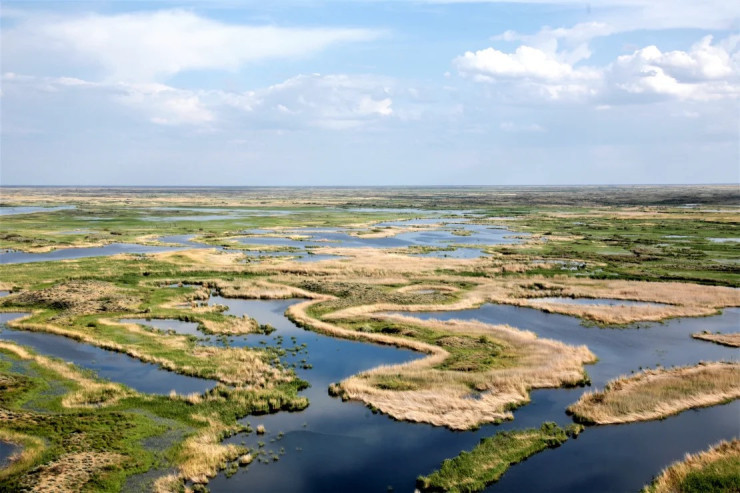Tengrinews.kz - The American media outlet CNN published an extensive piece about the Turan tigers, which were brought to Kazakhstan in September this year as part of a reintroduction program.
The tigers will inhabit the Ile-Balkhash State Nature Reserve, located in the Almaty region.
According to CNN, the Ile-Balkhash State Nature Reserve in Kazakhstan has changed significantly over the past decade. The ecosystem of this area, spanning about 4,151 square kilometers in the Almaty region, previously lacked large mammals, and its shrubs, wetlands, and forests were in decline.
However, by 2024, rare animals such as the Bukhara deer and the Kulan can already be seen grazing on more than 50 hectares of restored land.
 Aerial photography of the Ile-Balkhash Reserve in Kazakhstan. World Wildlife Fund. Central Asia
Aerial photography of the Ile-Balkhash Reserve in Kazakhstan. World Wildlife Fund. Central Asia
The return of tigers after 70 years
Soon, the region will become home to tigers, which have not been seen in the wild here for over 70 years.
Once, these predators roamed across all of Central Asia, which was part of their historical range extending from Turkey in the west to the Korean peninsula in the east, and from the northern Siberian territories of Russia to the tropical islands of Indonesia. Today, tigers occupy less than 7 percent of their former range. In Kazakhstan, the extermination of these predators through hunting and the reduction of their prey led to the disappearance of tigers in the Caspian region in the 1950s.
The first steps towards the return of tigers
In September 2024, two Amur tigers from the Stichting Leeuw center in the Netherlands were transported to Kazakhstan. They are now settling into a three-hectare area with semi-wild conditions in the reserve. It is expected that their offspring will be the first generation of tigers to reappear in the wild in Kazakhstan after decades.
"These tigers were selected because they’re very similar to what would have been found in the Caspian region (before their extinction)," says Stuart Chapman, head of the WWF Tigers Alive initiative.
Amur tigers, typically found in the Russia’s Far East, are well adapted to hot summers and cold winters, which matches the climate of the Balkhash region.
A long journey to the reserve
The tigers named Bodhana and Kuma traveled a long way: they were transported by land from the Netherlands to Germany, then flew a six-hour commercial flight to Kazakhstan, and finally were delivered to the reserve by helicopter.
Chapman calls this event an important step for wildlife conservation, bringing hope not only for the region but for the world.
"Tigers have been translocated within country boundaries, and zoo tigers cross international borders all the time, but that’s for them to remain in captivity. This is the first time that tigers have crossed international borders to reintroduce them into the wild," he emphasizes.
"Magic happens here"
Although the transportation of the tigers took only a few days, the project to reintroduce them has been in the works for decades, journalists note.
The intention to return tigers to Kazakhstan was announced back in 2010. In 2018, the Ile-Balkhash State Nature Reserve was established, and active efforts to restore the ecosystem began. The project is supported by WWF and the United Nations Development Program. As part of the initiative, animals that tigers hunt, such as the Bukhara deer and Kulan, which have also been absent from the area for nearly 100 years, were released into the reserve. Thanks to strict hunting laws, the wild boar population has also been successfully restored.
"Political will, well-managed protected area, and local adherence to hunting regulations have enabled the success of the project," Chapman notes.
Bodhana and Kuma were prepared for transport in advance: they were acclimated to transport cages and trained in hunting in conditions resembling the wild. After their arrival, they underwent a 30-day quarantine and were then released into a semi-open area of the reserve.
The future of wildlife
It is expected that by 2035, up to 50 tigers will inhabit the reserve. However, the work does not end there: an important task will be minimizing conflicts between tigers and humans.
Despite the lack of settlements within the nature reserve, around 6,000 people live in four villages along its borders. Educational programs and compensation schemes have already been created, and radio collars on the tigers will help warn residents of potential encounters.
"It’s not often, in conservation terms, the wildlife gets a second chance," says Chapman. And he adds, "Bringing back tigers to Kazakhstan is so significant in conservation terms."
Recall: On September 23, two tigers were brought to Kazakhstan from the Netherlands to restore the population of Turanian tigers.
